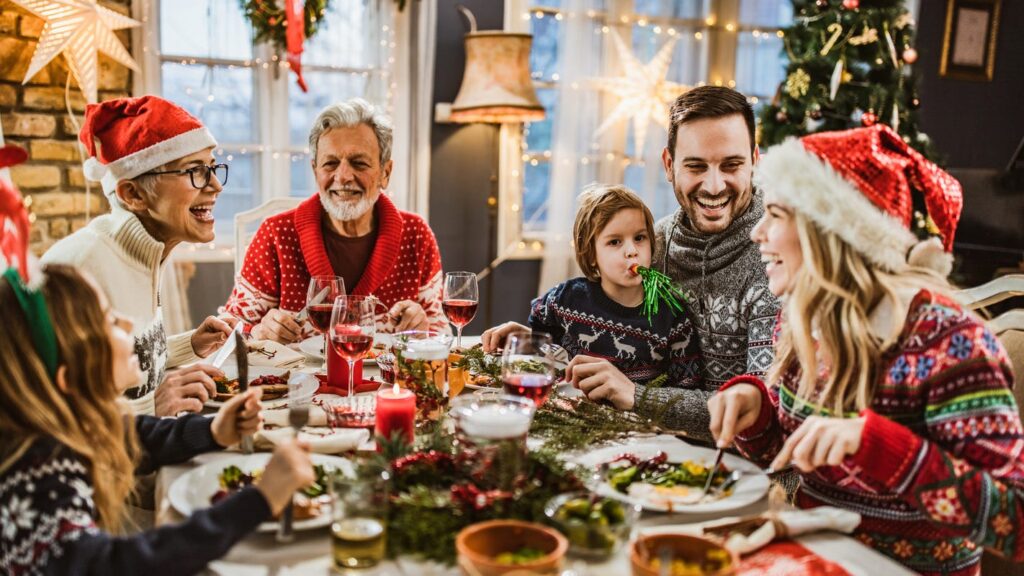The New Year is more than just the turning of a calendar page; it’s a time for reflection, hope, and celebration. One of the most cherished aspects of ushering in the New Year is the preparation and sharing of traditional recipes that have been passed down through generations. These recipes, often laden with cultural significance, bring families and communities together in a shared experience of joy and anticipation.
The Significance of Traditional New Year Recipes
Embracing Cultural Heritage
In a world that constantly evolves, holding onto cultural roots becomes more crucial than ever. Traditional New Year recipes serve as a tangible link to our cultural heritage, providing a sense of continuity and belonging. Whether it’s the fragrant spices of an Indian curry or the comforting warmth of a Southern stew, these recipes encapsulate the essence of our diverse backgrounds.
2.2 Symbolism in Every Dish
Beyond their delicious flavors, traditional New Year recipes often carry symbolic meaning. Ingredients may represent prosperity, good luck, or the banishing of negativity. Understanding the symbolism behind each dish adds depth to the celebration, turning a simple meal into a rich tapestry of meaning.
Popular Traditional New Year Recipes
Classic Roast Turkey: A Timeless Favorite
No list of traditional New Year recipes is complete without the iconic roast turkey. Its golden-brown exterior and succulent interior have graced countless festive tables, symbolizing abundance and togetherness. The art of roasting a turkey is a skill passed down from one generation to the next, creating a sense of continuity and tradition.
3.2 Hoppin’ John: A Southern Tradition
In the American South, Hoppin’ John is a must-have dish for New Year’s Day. This hearty combination of black-eyed peas, rice, and smoked pork is believed to bring good luck and prosperity. Each spoonful is a taste of Southern tradition, connecting families to their roots and fostering a sense of community.
Tamales: Unwrapping Good Luck
In many Latin American households, tamales take center stage during New Year celebrations. These pockets of masa filled with savory or sweet fillings are not just a culinary delight; they also symbolize the unwrapping of good luck in the coming year. Making tamales is a communal activity, strengthening familial bonds and creating lasting memories.
Cooking Techniques Passed Down Through Generations
Slow Roasting: Preserving Flavors and Tradition
The art of slow roasting, whether it’s a turkey, ham, or lamb, is a technique that transcends time. Slow cooking allows flavors to meld and intensify, creating a dish that is not only delicious but also steeped in tradition. As the aroma fills the kitchen, it’s a sensory journey back to the kitchens of our ancestors.
Fermentation: Transforming Ingredients with Time
Fermentation, a technique mastered by generations past, adds depth and complexity to many traditional dishes. From kimchi in Korea to sauerkraut in Germany, fermented foods are a testament to the transformative power of time. Embracing this technique connects us to age-old practices, highlighting the alchemy of turning simple ingredients into culinary treasures.
Spice Blending: Crafting Complexity in Every Bite
The art of spice blending is a skill that transforms ordinary ingredients into extraordinary dishes. Whether it’s the garam masala in Indian cuisine or the herbes de Provence in French cooking, the right blend of spices creates a symphony of flavors that dance on the taste buds. Passing down these spice blends ensures that each generation adds its unique note to the culinary melody.
Regional Variations in New Year Celebrations
Chinese New Year: Dumplings and Noodles Galore
Chinese New Year is a feast for the senses, with dumplings and noodles taking center stage. Symbolizing longevity and prosperity, these dishes are crafted with precision and care. The act of making dumplings together becomes a family affair, fostering a sense of unity and shared joy.
Rosh Hashanah: Sweet Beginnings with Honey and Apples
For Jewish communities celebrating Rosh Hashanah, the New Year is sweetened with the symbolic pairing of honey and apples. This combination represents a wish for a sweet and fruitful year ahead. Incorporating these ingredients into various recipes connects individuals to their cultural and religious roots.
Diwali: Sweets and Savories Illuminating the New Year
In India, Diwali marks the New Year with a dazzling array of sweets and savories. From decadent desserts like gulab jamun to savory snacks like samosas, the celebration is a feast for the taste buds. Each region adds its twist to the festivities, creating a tapestry of flavors that reflects the country’s rich culinary diversity.
Modern Twists on Traditional Favorites
Fusion Dishes: Bridging Culinary Cultures
As our world becomes more interconnected, so do our culinary traditions. Fusion dishes that blend flavors from different cultures have become a trend in modern celebrations. Imagine a Thanksgiving feast with a touch of Thai spices or a Christmas dinner featuring sushi rolls. These inventive combinations celebrate diversity and create memorable dining experiences.
Healthier Alternatives: Balancing Tradition and Well-being
In an era where health-consciousness is on the rise, there’s a growing interest in healthier alternatives to traditional dishes. From gluten-free stuffing to plant-based roasts, individuals are finding creative ways to balance tradition with well-being. These adaptations allow everyone to partake in the joy of festive meals without compromising on health.
Creating Your New Year Culinary Tradition
Family Cook-Offs: Fostering Togetherness
A delightful way to create lasting memories is by organizing a family cook-off during the New Year celebrations. Each member can contribute a dish, whether it’s a traditional family recipe or a modern creation. This not only adds variety to the table but also strengthens familial bonds through the shared experience of cooking and tasting.
Personalized Menus: Tailoring the Celebration
Tailoring the New Year celebration to personal tastes is an emerging trend. Instead of sticking to a rigid set of traditional recipes, individuals are creating personalized menus that reflect their preferences and dietary choices. This allows for a more inclusive celebration where everyone can enjoy the festivities without culinary restrictions.
Incorporating New Ingredients: Infusing Freshness into Tradition
One way to keep traditional recipes exciting is by incorporating new and exotic ingredients. Whether it’s experimenting with unique spices or introducing unconventional cooking techniques, adding a touch of novelty can breathe new life into time-honored dishes. This infusion of freshness ensures that the celebration remains vibrant and dynamic.
A Culinary Journey Across the Globe
European Elegance: Feast of the Seven Fishes
In many European cultures, especially Italian, the Feast of the Seven Fishes is a cherished tradition during the holiday season. This seafood-centric celebration involves preparing seven different fish dishes, symbolizing the seven sacraments. It’s a culinary journey through the flavors of the sea, creating a festive atmosphere of abundance and joy.
Latin American Vibes: Savoring Ceviche and Empanadas
Latin American New Year celebrations are known for their lively atmosphere and flavorful dishes. Ceviche, a dish of raw fish cured in citrus juices, and empanadas, savory pastries filled with various ingredients, are often featured on the menu. These dishes capture the vibrancy of Latin American culture and bring a burst of flavor to the festivities.
African Influences: Jollof Rice and the Spirit of Celebration
In many African countries, Jollof Rice is a staple dish during festive occasions. This one-pot rice dish, enriched with tomatoes, peppers, and various spices, symbolizes the spirit of celebration and unity. As families gather around the table to enjoy this flavorful dish, they share in the joy of the New Year together.
The Essence of Tradition: Beyond the Plate
Storytelling: Passing Down Recipes and Memories
More than just a collection of recipes, traditional New Year celebrations involve storytelling. As family members gather in the kitchen to prepare dishes, they share anecdotes, memories, and the history behind each recipe. This oral tradition ensures that the essence of the celebration is passed down from one generation to the next.
Festive Décor: Setting the Ambiance
Creating a festive atmosphere extends beyond the kitchen. Festive décor, whether it’s colorful banners, candles, or symbolic ornaments, plays a crucial role in setting the ambiance for New Year celebrations. These visual elements enhance the overall experience, making the celebration a multisensory delight.
Music and Dance: Creating a Multisensory Celebration
Incorporating music and dance into New Year celebrations adds another layer of joy and excitement. Traditional tunes and dance forms from different cultures infuse the gathering with energy and create a dynamic atmosphere. Whether it’s a lively jig or a soulful melody, music and dance elevate the celebration to new heights.
Embracing Change: Adapting Traditions to Modern Lifestyles
Virtual Celebrations: Connecting Across Distances
As the world becomes more interconnected, families and friends may find themselves scattered across the globe. Virtual celebrations have become a popular way to bridge the distance during the New Year. Sharing recipes, cooking together through video calls, and raising a toast online create a sense of togetherness despite physical separation.
Sustainable Practices: Nurturing the Planet While Celebrating
With environmental awareness on the rise, many individuals are incorporating sustainable practices into their New Year celebrations. From using locally sourced ingredients to reducing food waste, these eco-friendly choices contribute to a more sustainable and responsible way of celebrating. It’s a conscious effort to nurture the planet while enjoying festive traditions.
Mindful Eating: Savoring Each Bite with Gratitude
Amid the festivities, embracing mindful eating allows individuals to savor each bite with gratitude. Instead of rushing through meals, taking the time to appreciate the flavors, textures, and aromas of traditional dishes enhances the overall dining experience. Mindful eating brings a sense of awareness to the celebration, fostering a deeper connection with the food and the moment.
Conclusion
As we embark on the journey of a new year, traditional recipes serve as anchors, grounding us in the rich tapestry of our cultural heritage. From classic roast turkey to regional specialties like Jollof Rice, these dishes not only delight the palate but also weave stories of tradition, symbolism, and shared joy. Whether celebrating with family, and friends, or in virtual gatherings, the essence of these culinary traditions remains a constant, reminding us of the beauty in continuity and adaptation.





No Comment! Be the first one.